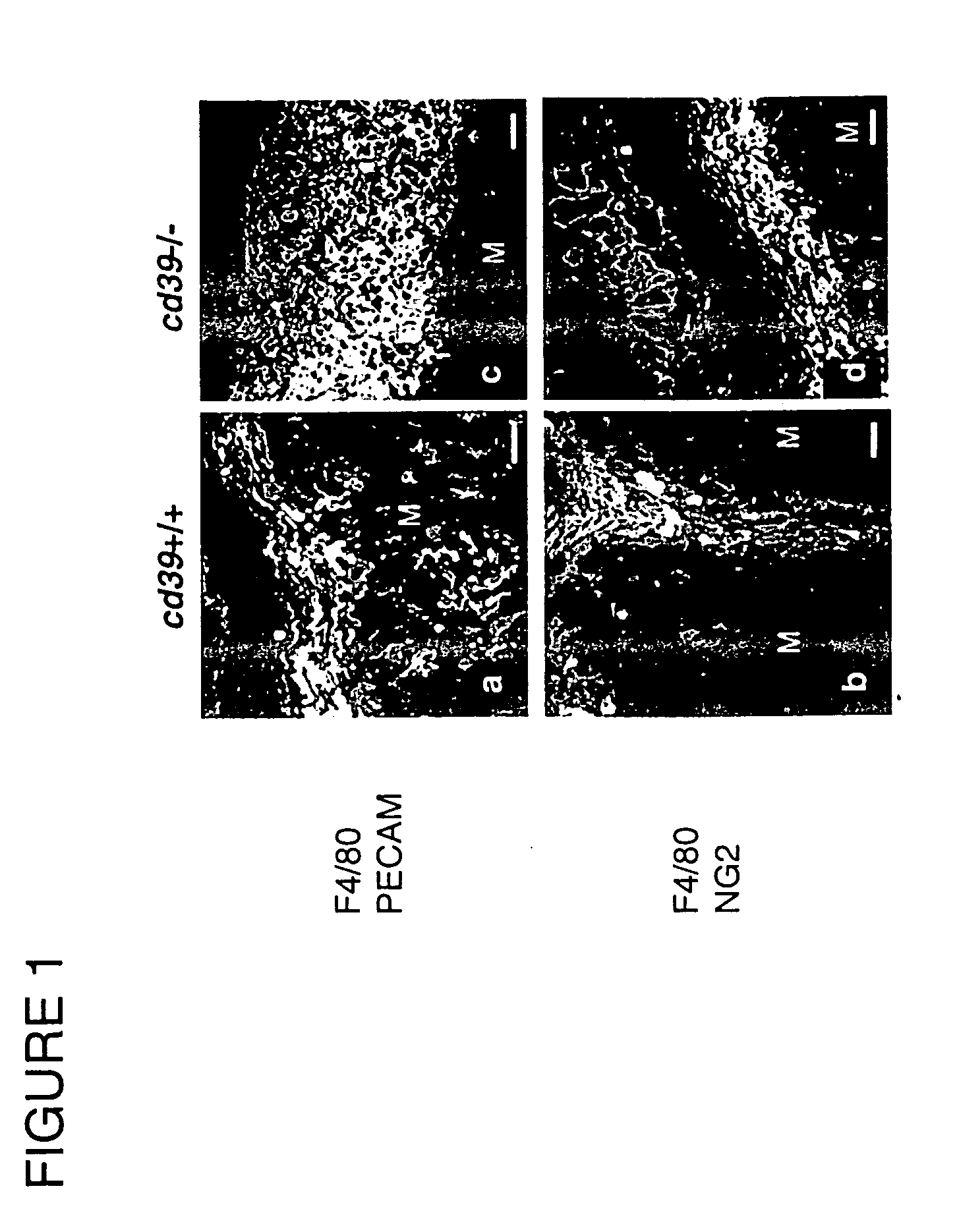Method of reducing angiogenesis
a technology of angiogenesis and angiogenesis, applied in the field of reducing angiogenesis, can solve the problems of reducing the activation of platelets, reducing the localization of p2 receptors on the cell surface, and complicating the path of nucleotide-mediated signaling, so as to prevent neovascularization, promote adhesion and migration, and maintain the balan
- Summary
- Abstract
- Description
- Claims
- Application Information
AI Technical Summary
Benefits of technology
Problems solved by technology
Method used
Image
Examples
example 1
CD39 Regulates Angiogenesis
Angiogenesis Model
[0184] Four MATRIGEL® plugs containing growth factors / additives from cd39-null mice (described in Enjyoji et al. (1999), and incorporated fully by reference) and 4 matched MATRIGEL® samples from wild-type mice were harvested at day 7. Six MATRIGEL® plugs containing all 3 additives from cd39-null mice and 6 MATRIGEL® plugs from wild-type mice were harvested at day 14. Four MATRIGEL® plugs containing all 3 additives from cd39-null mice and 4 MATRIGEL® plugs from wild-type mice were harvested at day 21. Two wild-type or mutant mice for each time point were injected with MATRIGEL® plugs containing only vascular endothelial growth factor (VEGF) / sphingosine-1-phosphate (SPP) and were also analyzed in parallel.
[0185] Tissues were analyzed at the 14-day point with regard to differences in alterations in vascular density at the interface between MATRIGEL® and underlying tissue, as well as observed ingrowth of vessels into the matrix (n=6).
[0...
example 2
Angiogenesis Impairment in cd39-Null Mice Bearing Tumors
Tumor Cell Inoculation
[0210] The murine tumor cell lines are: [0211] a) Lewis lung carcinoma (LLC) (ATCC Number: CRL-1642: Tumorigenic in C57 BL6 mice; Nature vol 390, 27 Nov. 1997; BLOOD, 15 Nov. 2000, Volume 96, Number 10). [0212] b) B16-F10 melanoma (ATCC Number: CRL-6457: Tumorigenic in C57 BL6 mice; Nature vol 390, 27 Nov. 1997; BLOOD, 15 Nov. 2000, Volume 96, Number 10). [0213] c) B16-CG melanoma (STRATAGENE Catalog #240046; The B16-CG mouse melanoma is an adherent B16 cell line stably transfected with the pVSneo-hCG plasmid. The growth medium is DMEM with G418 (250 ug / ml); Nature Medicine vol 6, 6 Jun. 2000).
Tumor Implantation
(1) Abdominal Wall Flap Angiogenesis Assay:
[0214] A triangular abdominal wall flap is fashioned in anesthetized mice. A subcutaneous area far from the edge of the flap is selected for the injection site. Under a dissecting microscope, 5.0×105 tumor cells in 0.1 mL PBS is injected in this ar...
example 3
[0222] The efficacy of using antisense-mediated inhibition of CD39 as a therapeutic has also been demonstrated by Imai et al., Biochem. 38:13473 (1999), which is herein incorporated fully by reference.
Antisense CD39 Decreases ATPDase Activity
[0223] The use of antisense CD39, previously disclosed in Imai et al., 38:13473-13479 (1999), and incorporated herein fully by reference, has been successfully used to modulate CD39 biological activity. Antisense CD39 was used as a specific inhibitory reagent to confirm the unique biological effects of this vascular ecto-enzyme. As there are currently no specific biochemical inhibitors for ATPDase, CD39 antisense oligonucleotides, complementary to a sequence that includes the translation start site, were generated. Suppression of ATPDase activity using antisense CD39 was associated with substantive changes in levels of extracellular ATP following endothelial cell (EC) activation in vitro. These results demonstrate the efficacy of using antise...
PUM
| Property | Measurement | Unit |
|---|---|---|
| Time | aaaaa | aaaaa |
| Time | aaaaa | aaaaa |
| Biological properties | aaaaa | aaaaa |
Abstract
Description
Claims
Application Information
 Login to View More
Login to View More - R&D
- Intellectual Property
- Life Sciences
- Materials
- Tech Scout
- Unparalleled Data Quality
- Higher Quality Content
- 60% Fewer Hallucinations
Browse by: Latest US Patents, China's latest patents, Technical Efficacy Thesaurus, Application Domain, Technology Topic, Popular Technical Reports.
© 2025 PatSnap. All rights reserved.Legal|Privacy policy|Modern Slavery Act Transparency Statement|Sitemap|About US| Contact US: help@patsnap.com



